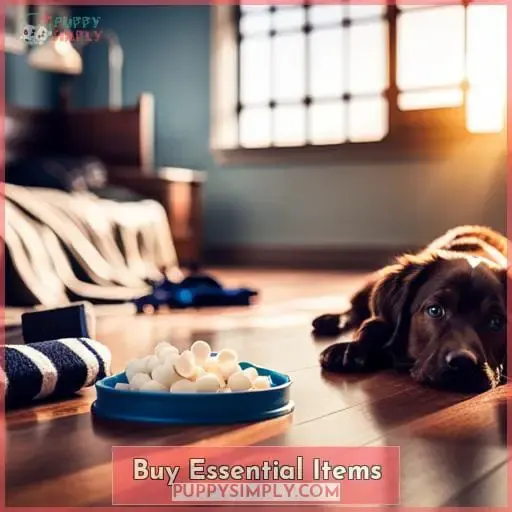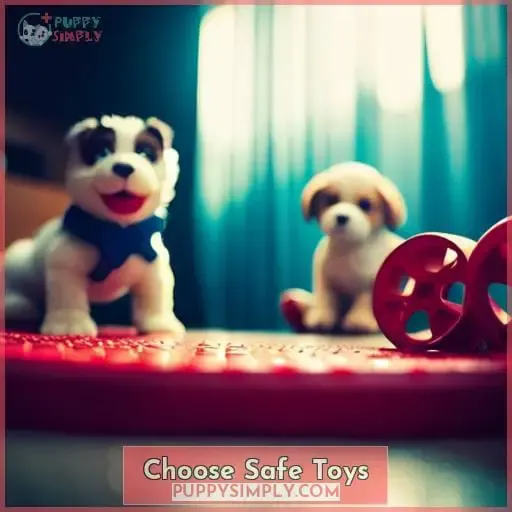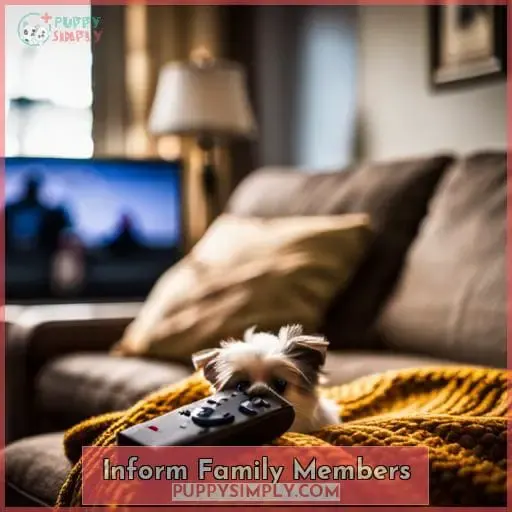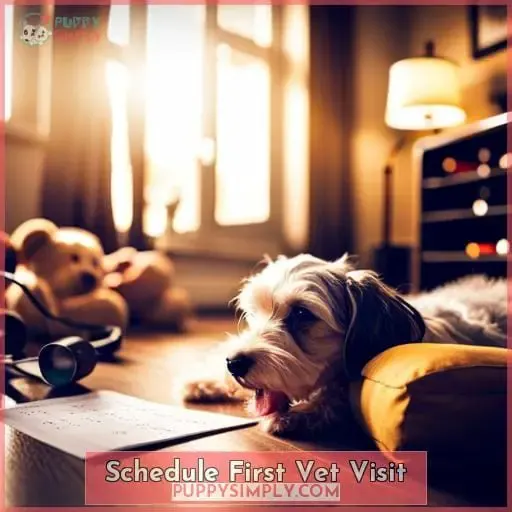This site is supported by our readers. We may earn a commission, at no cost to you, if you purchase through links.
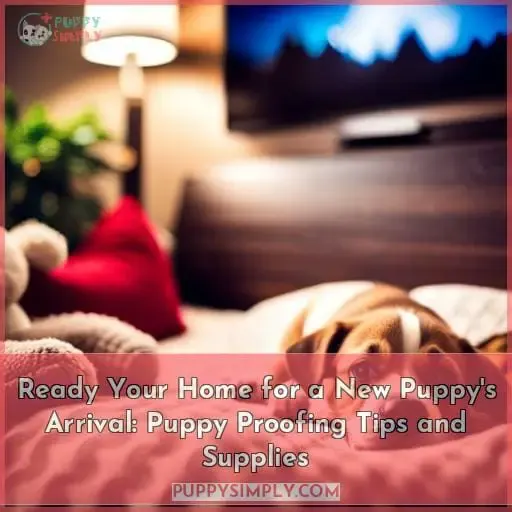 Whether it’s your first or fifth, welcoming a curious furball bounding through the house is joyously chaotic.
Whether it’s your first or fifth, welcoming a curious furball bounding through the house is joyously chaotic.
Yet being an accountable pet parent who ensures safety first fosters an environment where your new companion can thrive.
Start by scouting rooms, noting hazards, and setting boundaries with gates so your home nurtures rather than harms.
Prepare intelligently, and your new pup will reward your efforts with years of devoted companionship.
Table Of Contents
Key Takeaways
- Remove or secure potential hazards like electrical cords and blind cords
- Set up contained areas like a crate and playpen to keep the puppy safe
- Stock up on chew toys and beds to meet the puppy’s needs
- Introduce the puppy slowly to other pets to ensure everyone’s safety
Prepare for Puppy’s Arrival
When you’re preparing for your new puppy’s arrival:
- Start by puppy-proofing your home and setting up a safe space for them.
- Remove any small objects or hazards and secure cords to prevent chewing and accidents.
- Designate a room or confined area like a crate or playpen to introduce the puppy to your home gradually.
Stock up on:
- Chew toys and rotate them frequently to support healthy teething and prevent destructive chewing.
- A comfortable crate with bedding.
- Bowls, leash, collar, brush, shampoo, and nutritious puppy food.
Read up on:
- Training basics.
- Proper socialization techniques.
- Interpreting behavioral cues.
- Monitoring health and nutrition.
With some preparation, you’ll be ready to welcome your furry friend and begin a lifetime of memorable adventures together.
Puppy Proof Your Home
Before your new puppy arrives, you must puppy-proof your home.
Go through each room and remove any hazards or dangerous items the curious pup could get into, like loose cords or toxic houseplants.
Also, hide any wires, close off rooms you don’t want the puppy in, and store any items you don’t want chewed up or ruined.
Remove Hazards
You’ll need to puppy-proof your home by clearing out hazards before your new furry friend arrives.
- Remove loose items like rubber bands, paper clips, tacks.
- Tuck away electrical cords and tie up blinds cords.
- Use pet barriers to block access to unsafe areas.
- Spray bitter spray on baseboards and furniture legs.
- Check for holes in the yard where pup could dig or escape.
By taking preventive safety measures and hazard identification early, you can focus on fun instead of worrying during those precious first weeks together.
Providing a dog bed, pet barriers, poop bags, and non-toxic bitter spray helps remove hazards and keep your home safe.
Hide Cords and Wires
Hide your cords and wires to prevent your curious pup from chewing on them.
Concealing electrical cords protects pets and prevents hazards.
Use cord winders or raceways to bundle loose wires out of reach behind furniture.
Choose covered outlets and mount TVs high to limit access.
Consider wireless devices to reduce tripping risks.
Managing cables reduces electric dangers for pets while organizing your home.
Tucking wires out of sight deters puppy chewing and tangled messes.
Securing your cords simplifies pet-proofing for safety.
Thoughtful cord management welcomes your new puppy into a protected home.
Set Up Contained Areas
You’ll need to set up some contained areas to keep your puppy safe while you can’t supervise them.
A crate and playpen are essentials to have on hand before bringing a puppy home.
These allow you to restrict access until the puppy is trained but can still accommodate their needs for rest and play.
Crate
You’d want to set up a crate for the puppy as one of the contained areas in your home.
Selecting an appropriately sized crate ensures your puppy’s safety and comfort.
Place it in a low-traffic area, lined with soft bedding and puppy pads.
Introduce the crate slowly, making it a welcoming space with toys and treats.
Use the crate for naps, quiet time, and overnight to establish a routine.
Crate training teaches bladder control and provides a secure den when you can’t supervise.
Set ground rules so the crate remains a calming refuge, not a punishment.
Playpen
Next, have your playpen ready so the puppy has a safely contained space when unsupervised.
Place the playpen in a central area like the living room so the puppy can feel part of the family; the pen allows freedom yet limits access to dangers.
Although puppies have short attention spans, they need regular exercise or the playpen becomes a prison.
Rotate toys, provide chews, and introduce obedience commands during playpen time.
Gate off rooms and use baby gates rather than crating endlessly.
The pen provides security, stimulates play, and prevents housetraining accidents when you can’t watch the puppy.
Buy Essential Items
You’ll need to stock up on chew toys, beds, and bedding for your new pup.
Having appropriate chew toys on hand will help redirect any destructive chewing on furniture or shoes.
Prepare soft, cozy beds in both main living areas and the puppy’s crate to give them comfort in their new home.
Chew Toys
After setting up contained areas like a crate and playpen, you’ll want to buy some essential items like chew toys for your new puppy.
Chew toys provide teething relief, interactive play, and dental health benefits.
Choose toys made with safe, durable materials that provide mental stimulation.
Rotate a variety of chew toys to keep your pup engaged and avoid boredom.
Stick to chew-proof models to protect your home and prized possessions.
Having the right chew toys on hand will make enforcing house rules and cleaning up after your puppy much easier.
Beds and Bedding
Chew-toy puppies need their own cozy dog beds and soft bedding to call home in their crates or playpens.
Here are three essential items to consider when selecting beds and bedding for your new pup:
- Mattress selection: Choose a mattress that provides proper support and comfort for your puppy’s growing body.
- Bedding materials: Opt for pup-friendly textiles that are easy to clean, hypoallergenic, and durable.
- Cozy corners: Create inviting spaces with plush blankets or cushions where your furry friend can relax and feel secure during sleep training.
Choose Safe Toys
- Select durable chew toys made of nylon or rubber, like Kongs or Nylabones, since these withstand chewing better than plush toys.
- Rotate toys weekly by making some unavailable and introducing new ones to keep your puppy stimulated.
- Crate train right away so your puppy has a safe space for naps and quiet time.
Safe chew toy options
You’ll want to pick out chew toys made of hard rubber or tough nylon that can stand up to serious gnawing without breaking into pieces that could be swallowed.
Opt for varieties that soothe teething pain and promote healthy teeth and gums.
Interactive toys keep pups mentally stimulated while durable options like Kongs withstand heavy chewing.
Consult your veterinarian about appropriate chew items and supervise play.
Monitoring food, collar and leash usage, grooming, and health risks ensures your puppy’s safety.
Rotating toy selection
You’d keep your pup engaged by rotating their toys weekly. This prevents boredom while ensuring safety.
Rotate chew toys, balls, plushies, and puzzles to stimulate their mind, engage natural behaviors, and prevent destructive chewing.
Consult your vet on safe, durable toys.
Importance of crate training
Through rotating toys, you’re keeping your pup stimulated.
Crate training provides essential structure by designating a safe personal space.
Utilize crate training techniques like positive association and gradual acclimatization to establish the crate as a sanctuary.
These methods foster security while preventing separation anxiety.
Schedule an appointment with your primary care veterinarian from a compassionate team offering a large variety of services at their state-of-the-art animal hospitals.
Prepare Other Pets
Before introducing your new puppy, evaluate your current pets’ temperaments and vaccination status.
Protect all animals by ensuring they’re up-to-date on shots and parasite preventatives.
Go slow when introducing household pets.
Allow them to smell bedding or toys with the new puppy’s scent before meeting face-to-face.
Their first interactions should be brief and supervised.
Reward gentle, friendly behavior from your adult dogs or cats with praise or treats.
If any pet seems stressed or aggressive, seek professional guidance.
With patience and positive reinforcement, pets often grow to accept a new puppy.
But be ready to separate animals if needed and respect your adult pets’ boundaries.
In the initial adjustment period, focus on strengthening your bond with your new puppy while ensuring your other animals feel secure.
Gradually increase supervised playtime as all pets demonstrate polite behavior.
Ready a Puppy Room
Having prepared current pets, it’s time to ready a special space just for the new pup.
This cozy corner will be the furry fella’s retreat, a welcoming introductory haven in your home.
Choose a room the puppy can call its own with enough space for food, water, toys, and a bed.
This area allows the pup to adjust at its own pace.
Puppy-proof the room by removing hazards and blocking access behind furniture.
Offer chew toys to satisfy the puppy’s need to mouth.
Decorate the space with comforting smells the pup will recognize.
Bring a towel or toy from the breeder to provide familiar scents in this new environment.
Establishing a puppy’s retreat helps ease the transition to a new home.
Allow the small canine explorer to discover comforting zones and cozy corners within the safety of its own room.
This furry haven gives your new family member security as it adapts.
Inform Family Members
- Tell your kids the dos and don’ts for playing gently with the pup:
| Dos | Don’ts |
|---|---|
| Pet gently | Pull tail |
| Throw soft toys | Chase pup |
| Use quiet voices | Yell |
| Give treats gently | Take away food or toys |
| Praise good behavior | Tease or scare |
Family engagement with consistent training and care is key. Share puppy responsibilities, like feeding schedules, to build empathy. Set behavioral expectations for gentle hands and inside voices around the pup. Support positive interactions with praise and shared treat duties.
Consistency builds trust in your guidance. With structure and compassion, the whole family can welcome the new pup.
Schedule First Vet Visit
With your new pup, set up their first vet visit right after bringing them home.
This allows the vet to establish a baseline for your puppy’s health through an initial wellness exam.
The vet will likely cover several key areas:
- Vet Consultation about your puppy’s specific needs
- A Physical Health Check looking at eyes, ears, skin, etc.
- Outlining a Vaccination Plan to protect against diseases
- Discussing Preventative Care like flea/tick/heartworm medication
- Reviewing any Breed-Specific Risks to monitor
An early vet visit allows you to ask questions about your new family member and set them up for continued health.
Maintaining regular vet care provides peace of mind by catching any potential issues early.
As you build a relationship with the vet, they become a trusted resource for advice on your beloved pet’s wellbeing.
Through preventative care and early treatment, your puppy has the best chance at a long, healthy life as part of your family.
Frequently Asked Questions (FAQs)
How much exercise does my puppy need?
Puppy exercise needs vary based on age, breed, and overall health.
Aim for 5 minutes of exercise per month of age twice a day initially; adjust based on the puppy’s energy levels.
Prioritize positive socialization over strenuous exercise while your puppy grows.
Walks, play, and training meet exercise needs for most young puppies under 6 months old.
Consult your veterinarian for advice tailored to your puppy.
What kind of food should I feed my puppy?
When choosing puppy food, opt for high-quality commercial brands made specifically for puppies.
Provide age-appropriate nutrition to support healthy growth.
Consult your veterinarian for tailored recommendations.
How can I train my puppy not to bark excessively?
Reward quiet behavior with treats.
Ignore excessive barking or say enough! firmly.
Practice sit-stay commands to teach patience and consistency.
Regular walks and play will help curb boredom or anxiety barking.
Be calm but firm in reinforcing desired behavior.
What should I do if my puppy cries at night?
Stay patient, your puppy is adjusting.
Offer comfort like a snuggle toy and check for underlying needs.
Maintaining a consistent bedtime routine helps.
Consider moving the crate closer at first, then gradually move it to the desired spot over time.
Reassure the puppy you’re there, as this builds trust and security.
How do I introduce my puppy to children and other pets?
Introduce pets and children gradually.
Reward calm interactions.
Supervise all play.
Set boundaries from the start to build good habits.
Be patient – adjustment takes time.
Conclusion
With boundless energy bursting through paws too big for their body,
your home will seem minuscule to your eager pup exploring every nook.
Yet, preparing intelligently transforms your dwelling into a nurturing haven where your fuzzy friend can thrive.
Reward your efforts by witnessing their unbridled joy each day as devoted companionship blossoms for years to come.
Welcome home, pup.




